A South African Adventure – Part One
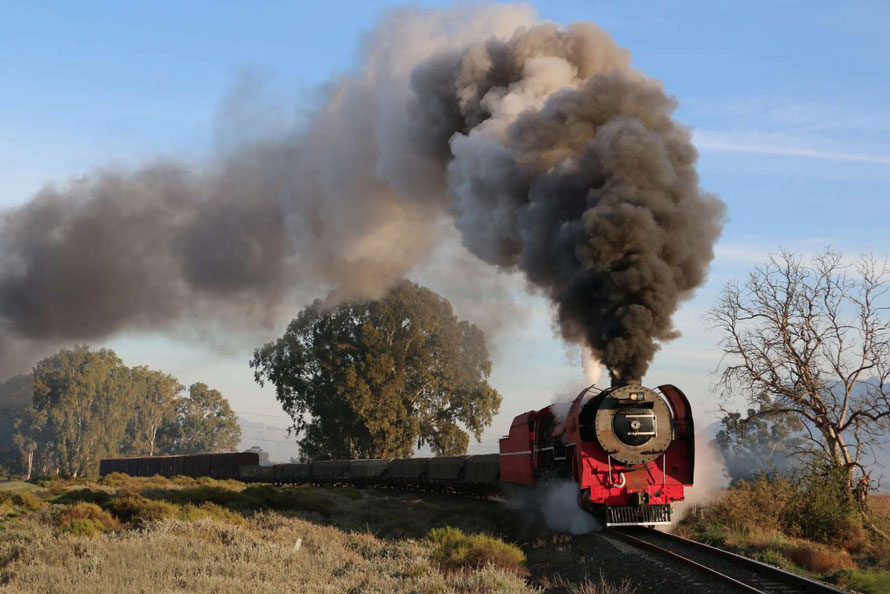
Long-distance steam rail-tours are nothing new to the South African railroad scene. The first of these 1000 mile-plus excursions was organized by South Africa’s Railway Society and Historic Transport Association groups in the 1970s and by the mid-1980s had become annual events. The trips were supported and encouraged by the state-owned South African Railways, who assisted by restoring a number of mothballed locomotives to full working order. Eventually, the publicity arm of the railways themselves also started running such tours, marketed under the name of “Steam Safaris” and very successful they were too! The interest shown by overseas and local visitors traveling on these trains convinced them to restore more vintage equipment for such operations.
By the early 1990s, the South African Transport Services Museum, which had become responsible for these tourist-steam operations, had approximately sixty vintage steam, diesel and electric locomotives on their books. Most had been fully refurbished in SATS workshops prior to the official end of steam in 1992. This, along with a roster of over fifty restored wooden-paneled-interior passenger cars, (some dating back to 1899) allowed for a comprehensive program of steam tours throughout the country. These were marketed under the “Union Limited” banner (the Union Limited was the crack express between Cape Town and Johannesburg and the forerunner to the luxury Blue Train of today).
Most trips were of six days’ duration and catered to the general tourist market, but longer two-week tours also were run for the more serious enthusiast. These were very well planned, complete with photo-stops, on the most scenic routes in South Africa and would use an amazing variety of locomotives, ranging from two 1890-built Class 7 4-8-0s, right through to the 1981-modernized Class 26 gas-producer 4-8-4, nicknamed the “Red Devil” due to its striking vermilion livery. Passengers slept on the train for the entire tour and full board was served by uniformed waiters in classic wooden-pillared dining cars. A lounge car next door to the diner allowed one to meet fellow passengers over a drink.
The zenith of these operations was in the late 1990s. South Africa had held its first democratic elections in 1994 and the country was enjoying a boom in tourism. But the contraction of rail in the country was starting to take its toll; many less viable lines were being mothballed, closed, and in some cases lifted entirely. Route-miles dwindled from approximately 22,000 in 1980 in to only 15,000 by 2000. A co-victim was the loss of infrastructure needed to operate steam; water supplies on tour routes were no longer maintained. The liability from fires due to cinder throwing from coal-fired engines also made steam unpopular with SATS management.
A further blow was the reorganization of SATS into Transnet Freight Rail and Passenger Rail Agency of South Africa, in which passenger operations in the country were delegated to a single operating entity (similar to AMTRAK). Nobody wanted the responsibility of the maintenance-intense museum collection and operations were gradually wound down, with the last trains being run in 2005. Locos were dumped as-is at depots and the collection was systematically reduced, some being sold to private owners or scrapped. Only some examples were securely stored at the South African Railway Museum. The passenger car fleet took the main brunt. Most were left in the open and suffered under the elements or were vandalized. A fire in 2012 at the old Union Limited workshops where the more valuable examples were being protected, destroyed over twenty vehicles.
By 2010 the SATS Musuem collection had been reduced to a third of its original inventory. A few private clubs soldiered on with railway preservation, but, for most purposes, the golden age of the “Great South African Steam Safari” seemed to be over, never to be relived.
Ceres Rail (and on Facebook) is a concession (short line) operator that began freight operations in 2014 on the Transnet owned Ceres branch line, some seventy miles from Cape Town. This line serves the fertile Ceres valley and traffic is mainly containerized deciduous fruit and fruit products such as fruit juices. As part of the concession deal, some of the Union Limited passenger equipment and three steam locos for running tourist trains on the branch were included in the package. The famous Red Devil was also leased by Transnet to Ceres Rail and another loaned by a private owner. There was good public response to these trains and within two years, Ceres operations had expanded to run day-excursions on a number routes out of Cape Town.
In 2017, a German-based railway-tour company, FarRail Tours, approached Ceres about operating a photo charter similar to the Steam Safaris of old. The requirement was for a nine-day tour on the most scenic routes out of Cape Town using the entire Ceres Rail loco fleet, including the Red Devil, at various stages. The train itself had to be typical of the 1970s era. Scheduling was to be for early-morning predawn departures with the maximum number of high quality photo-stops to be performed each day. The tour group would consist of thirty to forty “hard-core” photographers and videographers. “Getting the shots” was paramount!
Management were initially doubtful of such an undertaking. Chief concerns were the operation of a train solidly for nine days in a row with little chance of recovery in case of a locomotive failure or other operational problems. While they had gained considerable experience in operating day excursions and even a few overnight trips, they had done nothing of this scale (and these people still want to stop every five minutes and take photographs!?) But the senior steam-loco engineer at Ceres Rail, Cassie Carstens, who had previously worked on many Union Limited photographic trips, advised “there would be no real problems” and after further “what ifs?’’ being discussed and resolved, the go-ahead was given.
The first proposed schedules were way over-ambitious and we trimmed these down considerably. Costs were a significant limiting factor. In addition, we were prohibited from operating steam overnight, and as the trip was planned for the middle of the South African winter, this gave us an eleven-hour operating window which had to include time for servicing along the way. And then there were the photo-stops themselves, which took a further slice out of the running time and distances. Also, normal service trains would take priority over the path of our train and had to be allowed for (or preferably avoided altogether). Despite these constraints, the tour plan was gradually optimized for the maximum number of photo-stops for minimum mileage on the most scenic routes. In the end we did a maximum of 120 miles a day, most days even less.
A basic budget was agreed to and the itinerary defined:
- 4 days on the regional branch line from Cape Town directly north to Klawer (pronounced Clarver)
- 1 day on the ultra-scenic Wolseley – Ceres line
- 4 days on the equally scenic west-east Worcester – Swellendam line, including a day with the Red Devil
Although these routes are not geographically far apart, they differ greatly in character and would provide good photographic variety over the nine days.
FarRail required the train to be painted in the old South African Railways red and grey livery of the 1970s (somewhat like a reversed layout of the Eire Lackawanna passenger color scheme.) Repainting a full set of passenger cars from (and back into) the Ceres Rail corporate red would be expensive, so to make up a reasonable looking load, a traditional South African mixed (combined) train using just three passenger cars was decided on. This, in turn, solved the problem of furnishing locomotive supplies on the journey (Ceres were totally responsible for arranging all oil fuel, coal and water used throughout) – this would now be conveniently carried in the freight cars.
The train was eventually made up from a maximum of twelve vehicles – four empty grain box-cars, two tanks of loco water (in case of supply emergencies), two gondolas for fuel (one with oil in plastic tanks, one with bagged coal), a tools and spares boxcar and then the three passenger cars, one for staff accommodation, the other two day-sitter types for passenger use. The freight cars were hired from Transnet. All these had to be selected from hard-to-find 1980s-era vacuum braked equipment. The locomotives’ water feeder tanks were specifically not to be marshaled adjacent to the locomotive when running and the consist was to be varied daily. On days when we had two locos, we sometimes ran two trains simultaneously, one as a support train. It required complex planning.
The lack of overnight on-train accommodation also meant that passengers would sleep in hotels. This too had to be organized and booked, road coach transport to and from the hotels also being required. Packed on-train catering (breakfast and lunch) was arranged with local suppliers.
And all this was to remain within the overall budget…
In the meanwhile, the locomotives were gradually prepared. Ceres Rail’s Class 19B’s (4-8-2 No. 1412, built in Germany in 1930) driving wheel journals were extensively worn and she was shopped for major overhaul, a mandatory boiler certification also being obtained. Fortunately, the boiler was still in good condition, having been replaced in the 1990s under the SATS overhauls. Of the other locos, Class 19D 4-8-2 No. 3322 and 2-8-4 Class 24 No. 3655 (both built in UK in 1948) were already in regular excursion use and were in reasonable condition. Only the Class 26 4-8-4 No. 3450 (the Red Devil) remained a problem child, with iffy valve rings and superheater issues, but these were also repaired in time.
Personnel rosters were drawn up. Ceres Rail employs a full-time Operations Manager, two steam-locomotive engineers and a single fireman, but the remainder of the locomotive and operating staff are drawn from a volunteer pool, some of who would have to take leave from their normal jobs. So all this had to be planned well in advance. In addition, in case of sickness or other problems, standby crews had to be arranged. All key staff had to be certified and some validated for route knowledge on the lines we would visit. In the end, we had twenty-four Ceres members involved on the tour: two engineers, six firemen, five fire-lighter/minders, one general loco assistant/coal trimmer, the Ops Manager, four conductors, three repair fitters, one cleaner, one support road-vehicle driver (but not all simultaneously – thankfully.)
The departure date loomed even closer, but the list of preparations did not seem to diminish. The routes on which we were to run had been certified as operational by Transnet, but to make 100% sure, essential passing and turning points on these lines were physically checked by Ceres for the maintenance of switches and for clearances. Photo-stop locations were also checked. We planned to replenish water from a number of fire hydrants en-route and these had to be surveyed for quantity, water quality and rate-of-flow. At one town, where loco water supply was critical to our planning, but totally non-existent, a local cement manufacturer generously agreed to install a water-point fed from their factory’s supply. Front loaders and crane trucks for re-coaling were hired in certain towns.
Two weeks from the start saw the repainting of the selected cars, the return of No. 1412 from shops, the test steaming and fettling of the other locos, road-certification of the passenger cars and the myriad of minor tasks that needed to be completed: the delivery of selected freight cars from Transnet, coal, oil and water loaded, spares and tools stored in the spares car, oil and water hoses and pumps checked, refreshment and catering supplies for both passengers and staff to be loaded, restocking of first-aid kits, gasoline for the on-train power generator and last minute work on car electrics, and enough toilet tissue for 9 days.
Saturday 15th June 2019 dawned bright and sunny in Cape Town (this is normally the start of the Cape’s wet season and the weather can be quite dismal). We were still finishing up when passengers started to arrive, most of them having flown into the country overnight. After a welcoming lunch at the nearby Royal Cape Yacht Club, forty-five passengers of nine different nationalities boarded the train. At 2:00 pm Nos. 3322 and 3655 whistled up and we departed on time. So far so good…
But would the whole tour work out as we had planned? The following photos tell you our story…
Saturday 15th June 2019
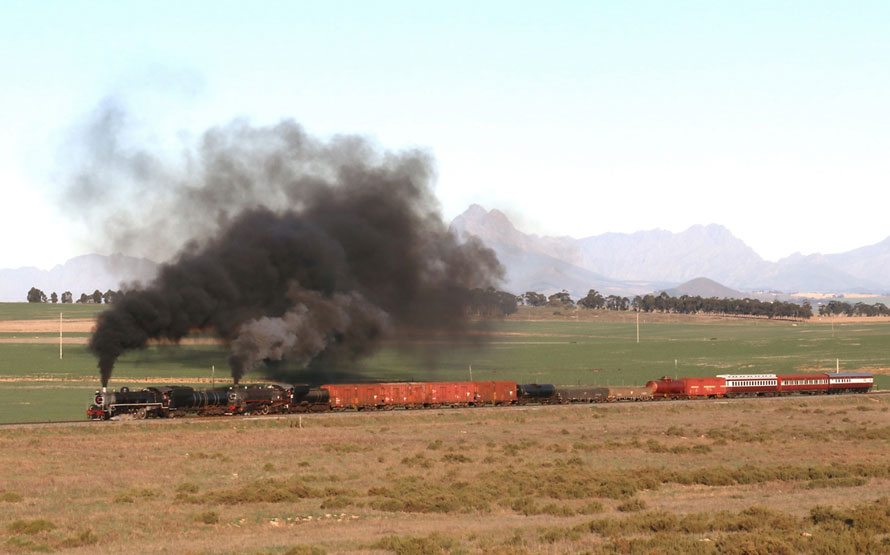
The first day was spent getting out of Cape Town and onto the regional branch towards Klawer and the first photo-stops were performed, allowing participants to exercise their shutter fingers in preparation for the next nine days. At the end of the day the train tied up at Malmesbury, some fifty miles out of Cape Town. Train staff spent the night onboard, passengers returned to Cape Town by road coach. After a 4:30 am wake-up call (the first of many…) they would rejoin the train at 7:00 the following day.
Sunday 16th June 2019
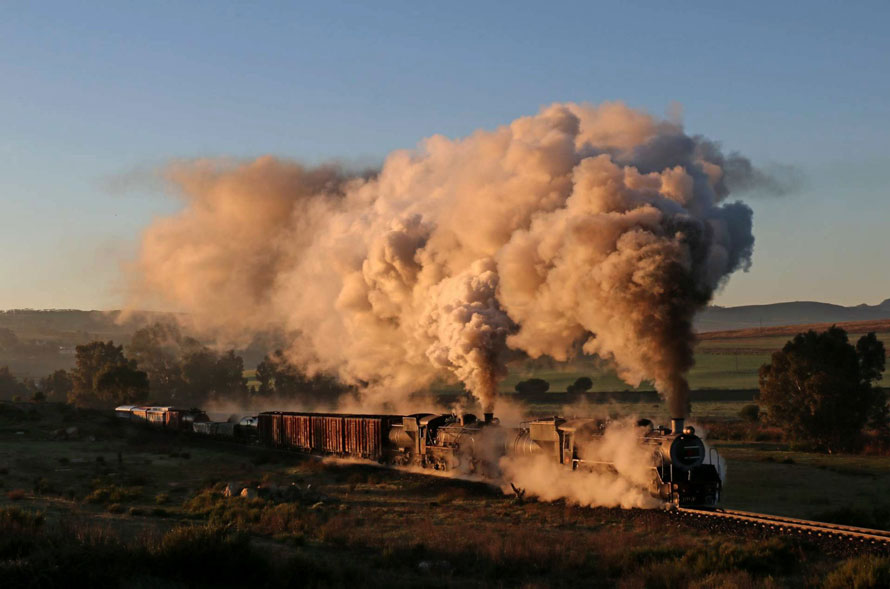
The reason pre-dawn departures were essential is shown vividly in this photo. We had left Malmesbury at first-light a half-hour before and the photographers were already off the train and in position, waiting for the first rays of the sun to hit the tracks and then, almost instantly, it was show-time! “Call the train on, NOW!” Afterwards, one passenger was heard to remark, “Well, that’s it then. Might as well go home – not going to get better than this!” I bet he was glad he didn’t. This was one of many days of almost perfect photographic opportunities!
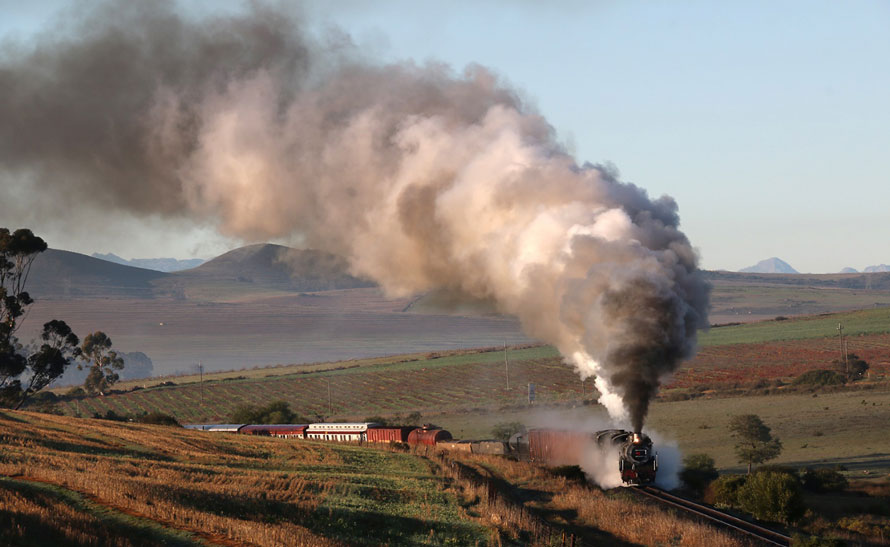
The clock has been turned back by fifty years, but would we be able to keep it wound and chiming for the next eight days?
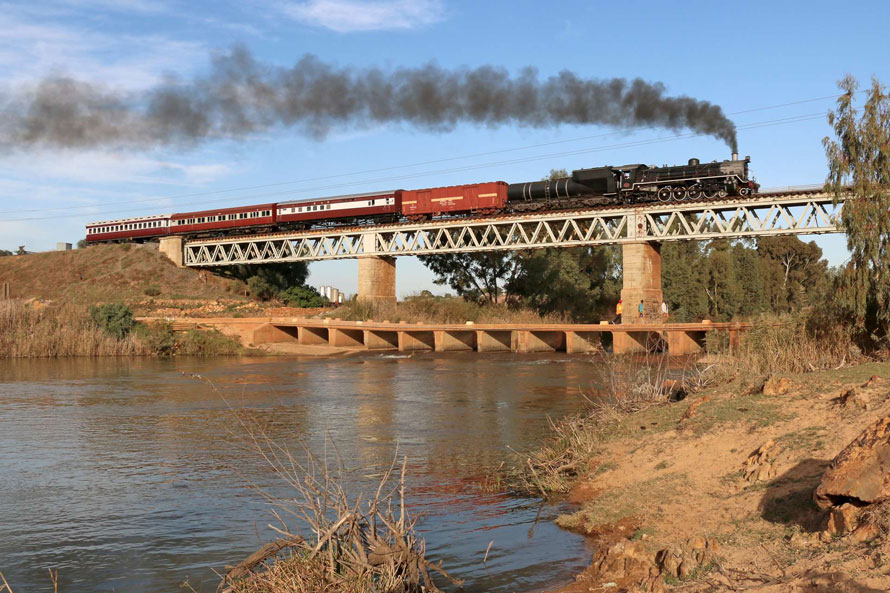
Altering the train consist for photographic variety was an essential part of planning. In the afternoon, after reaching the town of Piketberg, the train was turned and made up into a short passenger train.
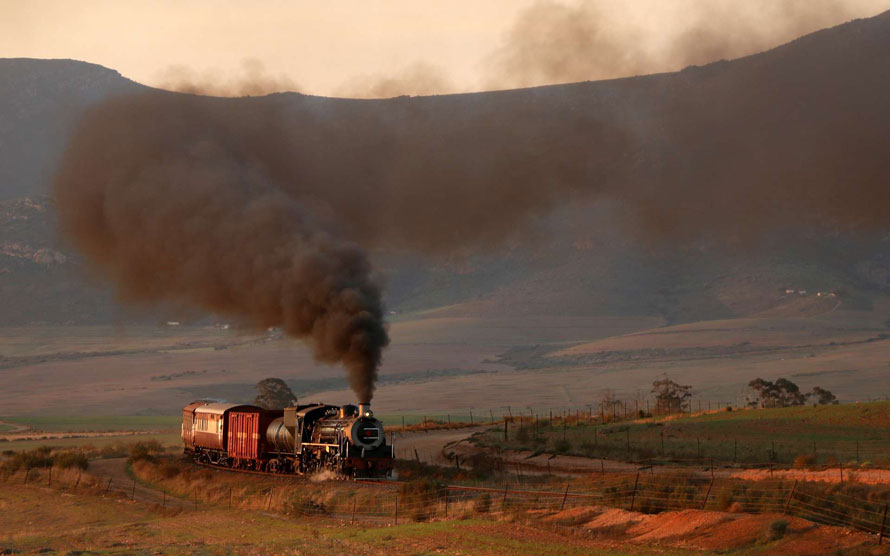
After this, our passengers, very satisfied, overnight-ed at a local hotel. It had been a good day for everyone.
Monday 17th June 2019
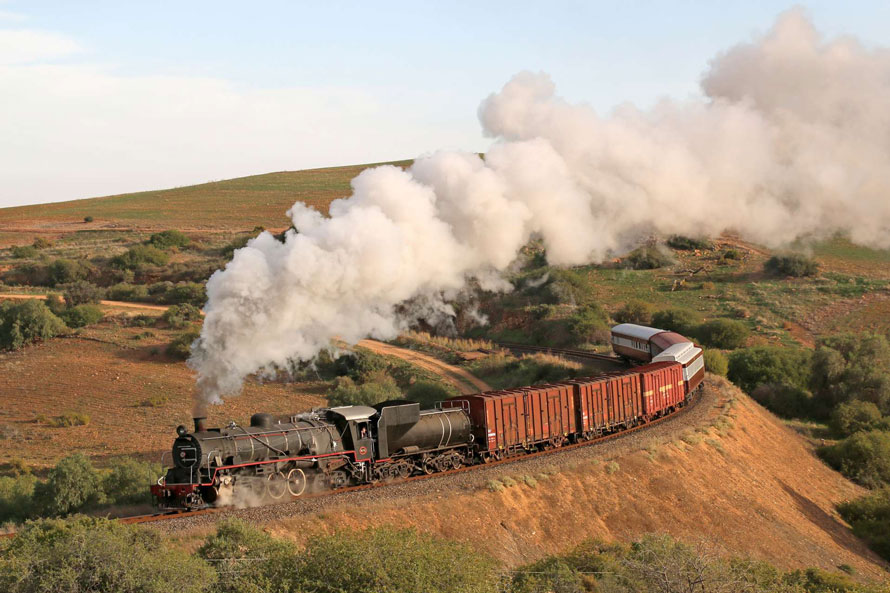
No. 3655 is normally a super-shine machine, but FarRail had specified that the locomotives were NOT to be cleaned or decorated before the tour. A work-worn lustre would make the photos look more realistic.
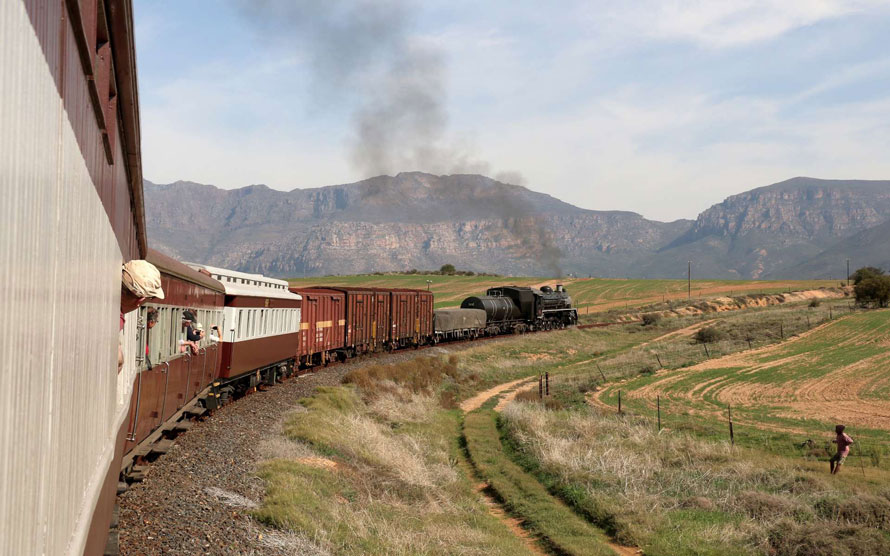
No. 3655 would follow, running tender first, with the service part of the train. This was required as there were no turning facilities north of Piketberg and we needed No. 3655 to be facing south for the next day’s return journey.
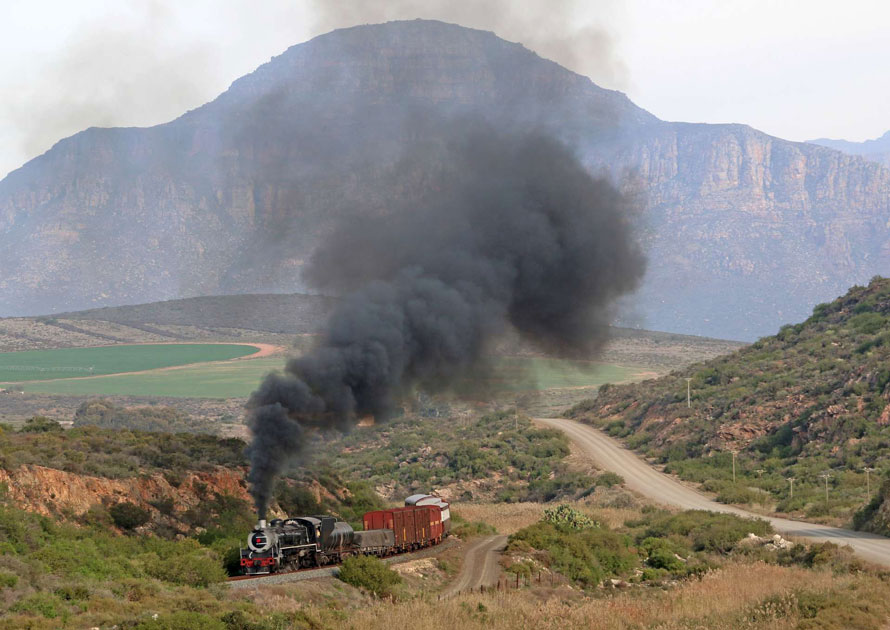
We had disembarked from the train and were following by road. However, our road coach operator would not sanction the use of the coach over the rough gravel roads in the area. The answer—a friendly farmer provided a work-truck for our transport. This was very useful as it provided a mobile grandstand from which to photograph.
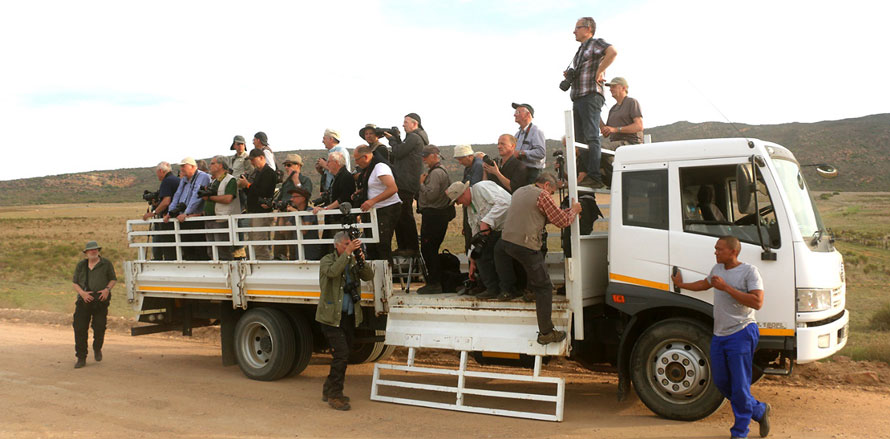
Tuesday 18th June 2019
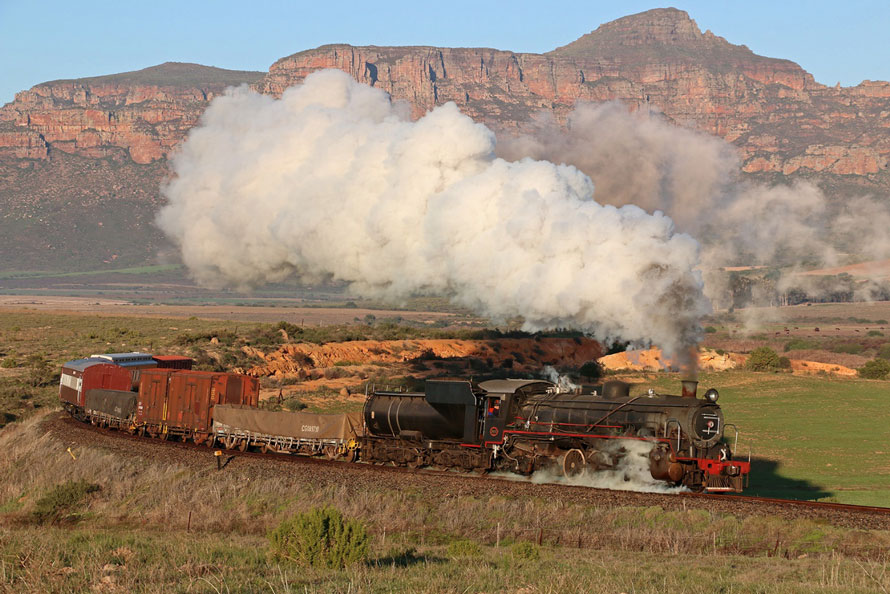
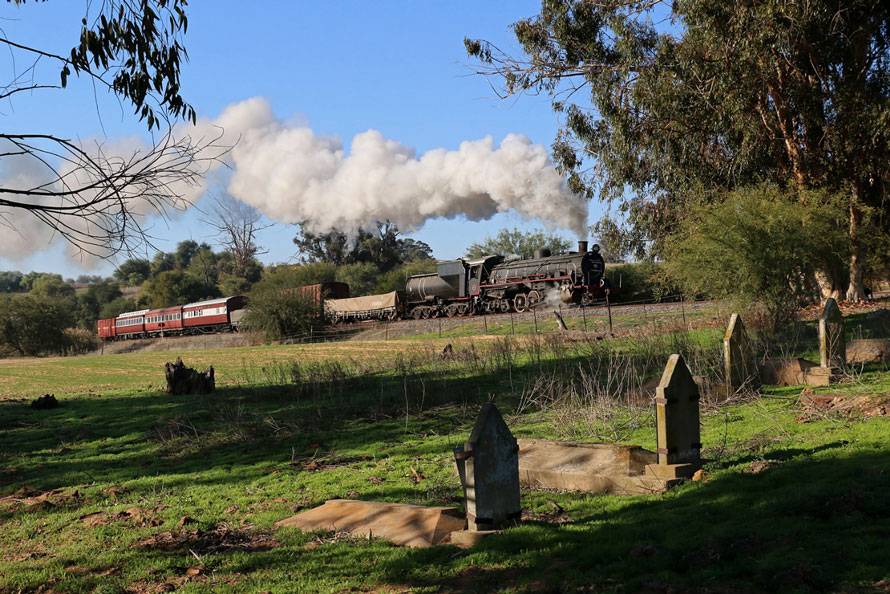
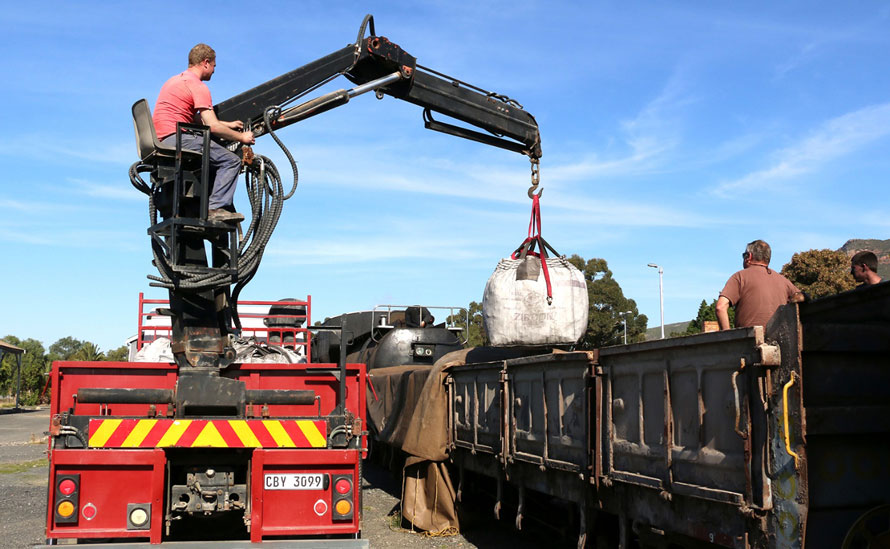
It was No. 3322’s turn to follow tender-first with the support train. At Piketberg No. 3322 and No. 3655 were reunited and both trains were recombined into a single consist for the return run south to Cape Town. Before that could happen, however, both locos had to be refueled. Passengers left the train at Malmesbury and transferred by coach to the town of Ceres that evening. The train continued through to Cape Town.
Wednesday 19th June 2019
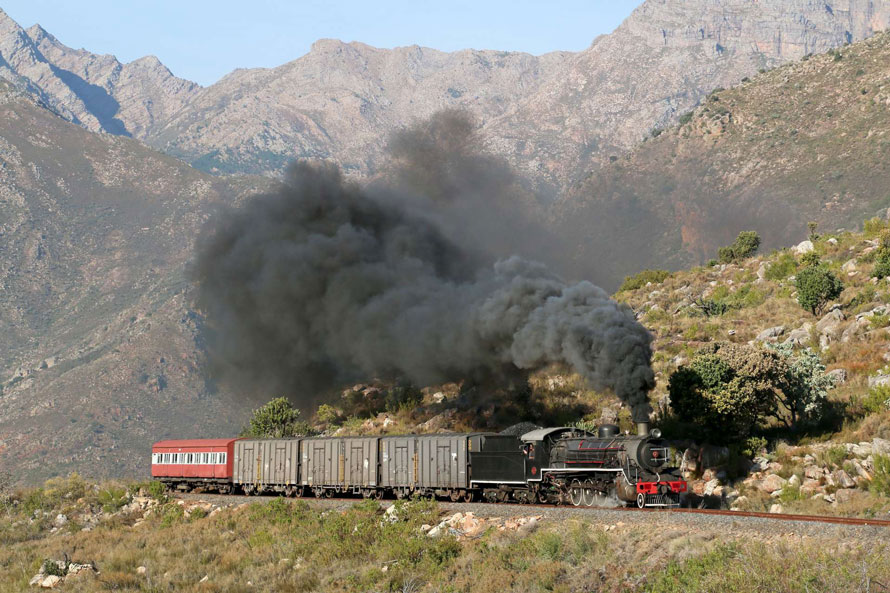
Although the Ceres line is only sixteen miles long, it transverses the spectacular Michell’s Pass and probably has more photo locations per mile than any other line in South Africa. It was well-worth the visit. We did about a total of fifteen photo-stops that day!
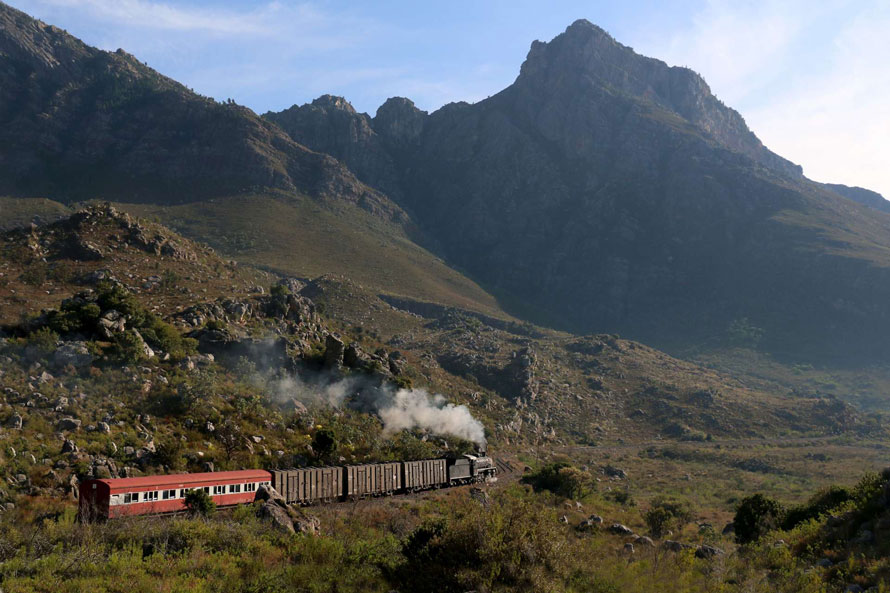
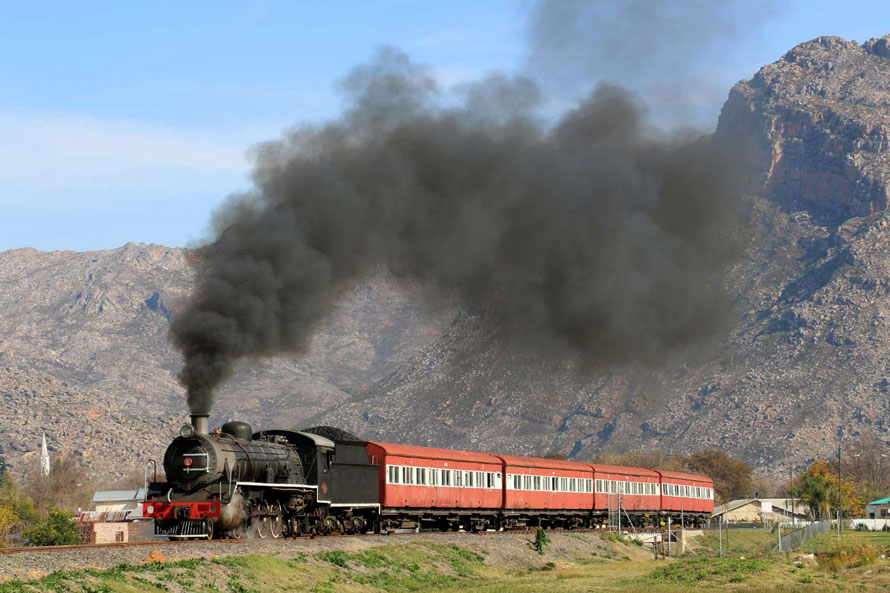
After arriving at Wolseley junction, the 19B took the passengers on down the mainline to the regional centre of Worcester. In parallel at Cape Town, the Class 24 had been put to bed, No. 3322 refueled and the Red Devil lit-up and prepared for a double-headed service hop to Worcester. By the day’s end, we had the three locomotives, plus our original train at Worcester.
Thursday 20th June 2019
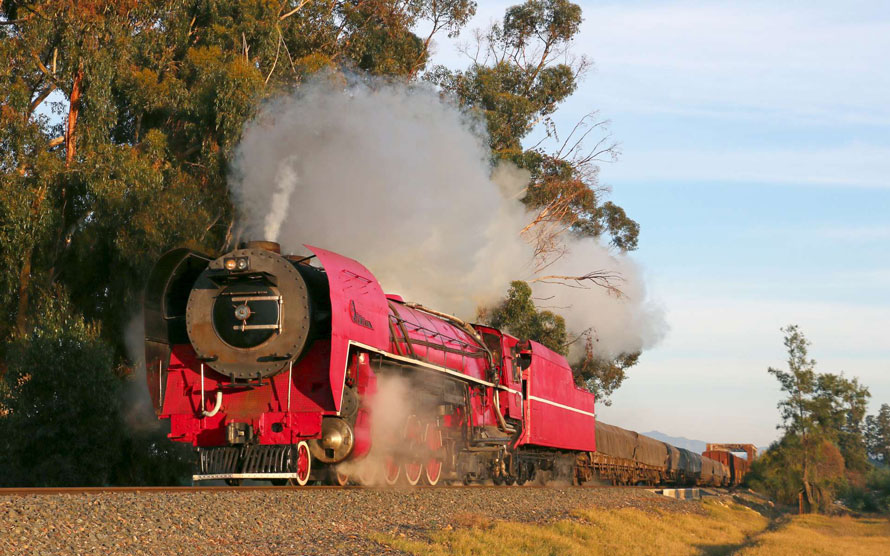
No. 3450 was built in 1952 as a conventional coal-fired 4-8-4. In 1981 it
was converted along gas-producing fire-bed principles developed by Argentinian engineer L.D. Porta, and by David Wardale, a British engineer who was working for SATS. The locomotive was painted in its signature vermilion-red livery by Wardale to attract attention. The performance results were very impressive with a 43% increase in drawbar power, combined with a 25% reduction in fuel consumption. But SATS had already decided upon their steam elimination program and no further conversions of the existing steam fleet were authorized. The engine is retained as part of the Transnet heritage collection and is leased to Ceres Rail. A tantalizing glimpse of what might have been…
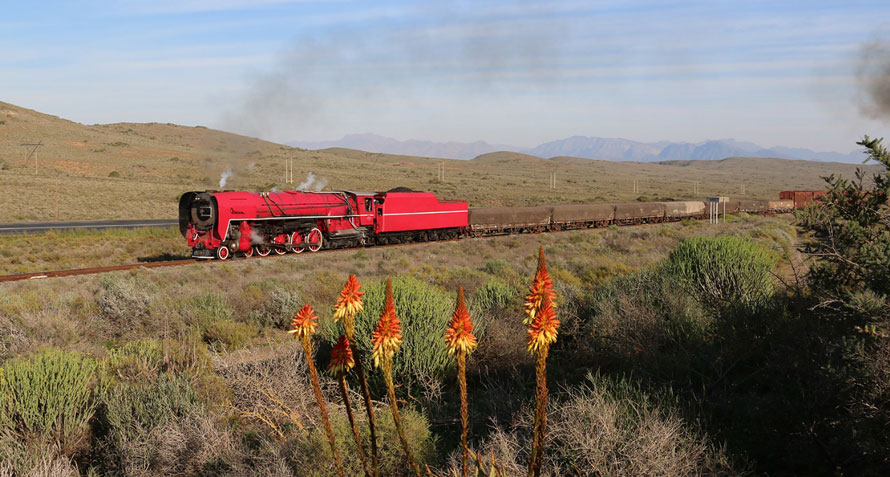
Arrangements had been made for the day in that we were to leap-frog the Red Devil out and back to Ashton by coach, stopping at various pre-selected photo locations ahead of the train. We would be in radio contact to control the speed of the train. We had a load of seven gondolas loaded with bagged cement as well as a number of grain-cars to make up a realistic looking train to match the loco, and we wanted the train to pass the photo-line at speed, so reversing a suitable distance every time for photos would be impractical. Total train weight was about 800 tons, maybe not impressive by USA standards, but on this steeply graded (2%) line, the Devil certainly had its work cut out for it.
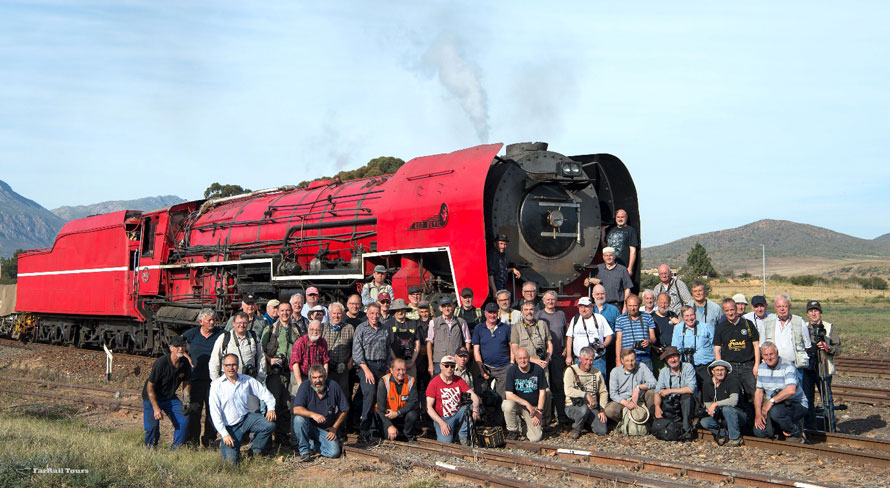
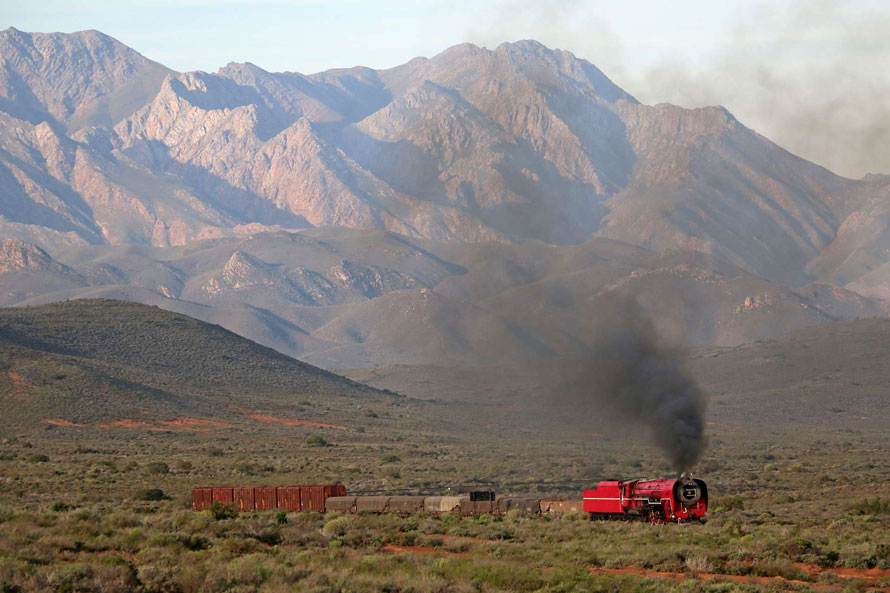
Friday 21st June 2019
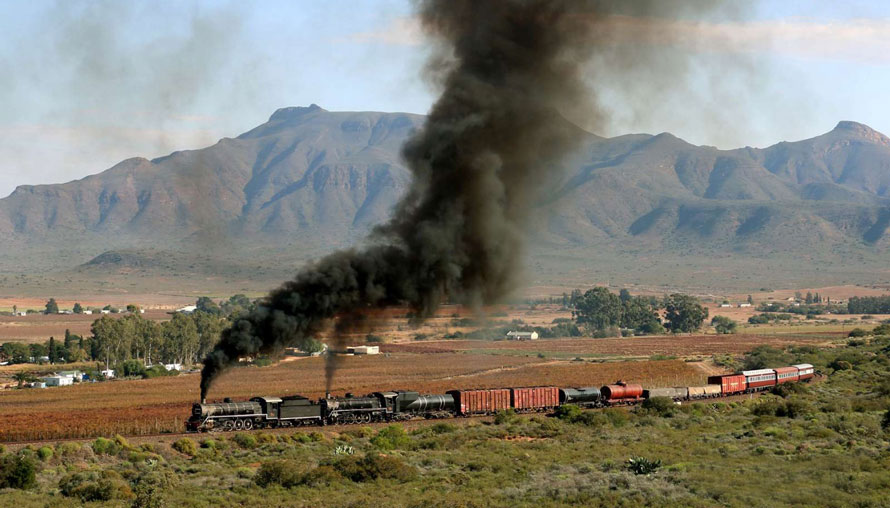
The next day we were to repeat the Worcester – Ashton leg of our journey, but this time riding onboard the train with the 19B and the 19D as head-end power. At Ashton we split the train before continuing further along the line with just the 19B. The 19D turned and followed tender-first with the service load.
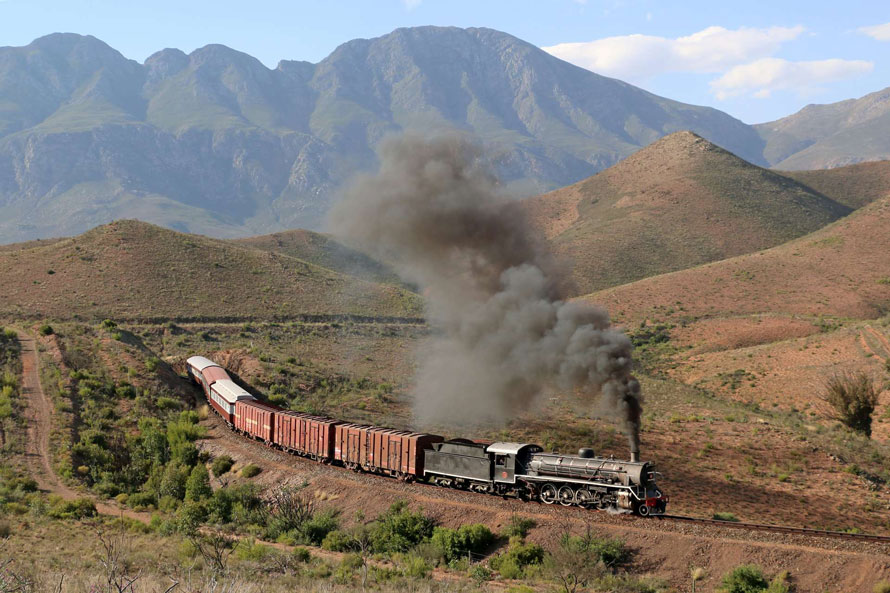
Later that day she was to provide one of the most memorable glint shots (below) of the tour. A weather front was rapidly approaching and dark clouds had obscured the sun, but there was always a chance that maybe, just maybe, we would get a break. We stood waiting for almost an hour, peering up at the scudding clouds. And then, IT happened! Again, it was “Call the train on, NOW!” By the time the train had passed us, the sun was finished for the day.
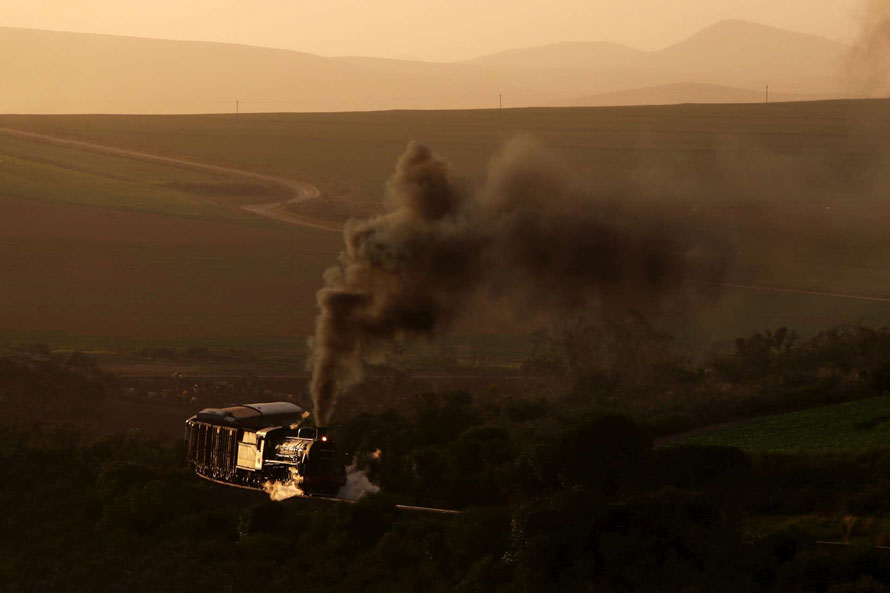
Passengers departed by coach for local hotels, while the train tied up at Drew, a remote country siding
Saturday 22nd June 2019
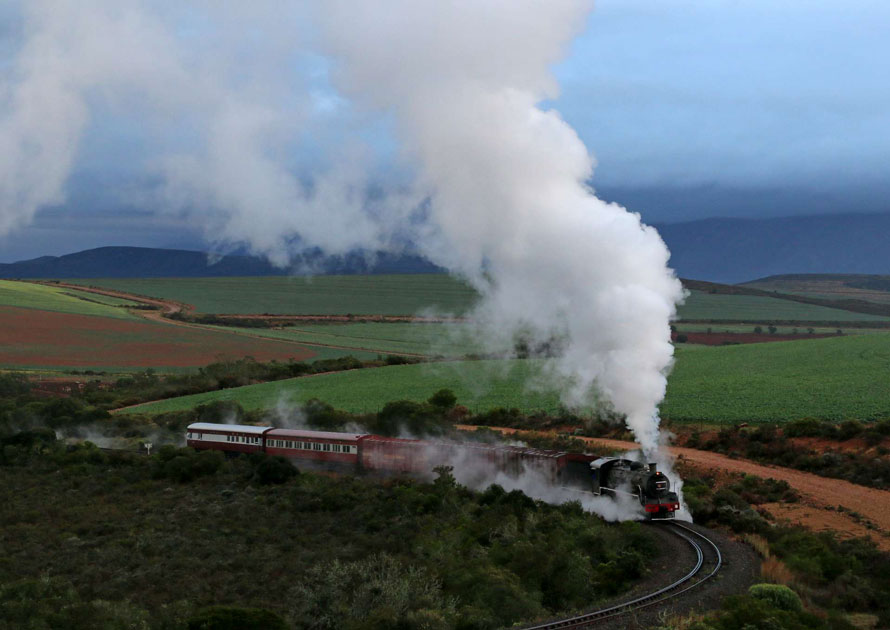
We had been very fortunate with the weather for the last 7 days, as it is normally the Cape’s rainy season. Today was the only completely bad-weather day we had on the whole tour, but that did not dampen participants’ spirits and they were still out for photo-stops. We had the 19B take the train from Drew to the town of Swellendam. The 19D had departed tender first a half hour beforehand and was ready and waiting there to return us to Ashton in the afternoon. The 19B rejoined us at Ashton later that evening.
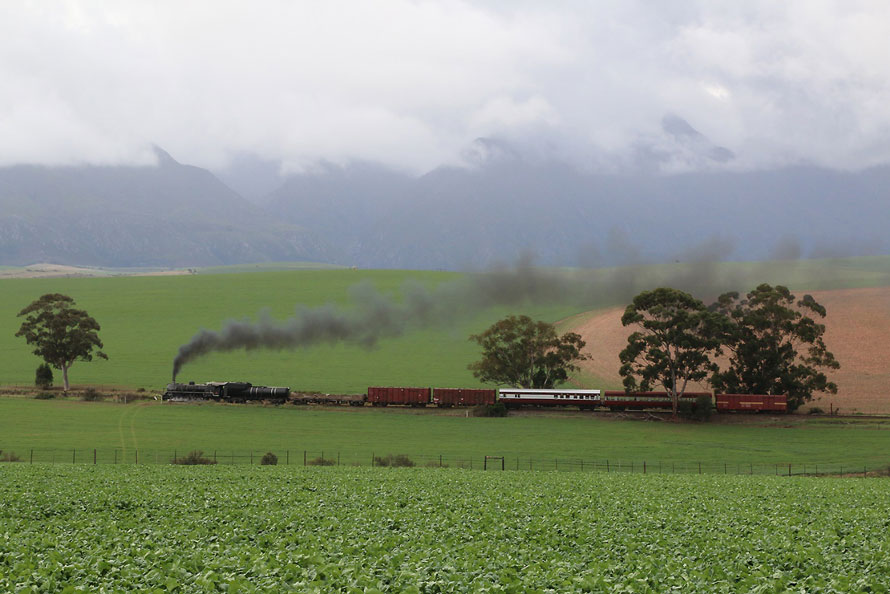
Sunday 23rd June 2019
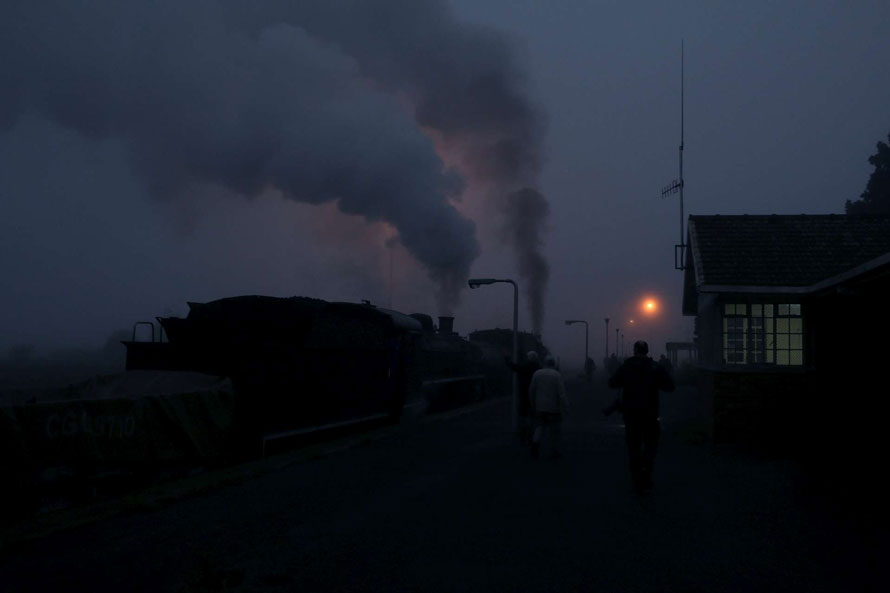
The morning was damp and foggy for our return from Ashton to Worcester, which led to some interesting photographic possibilities in the misty conditions (above and below). However, by 10:00 am this had cleared and the sun was shining brightly as we rolled into Worcester.
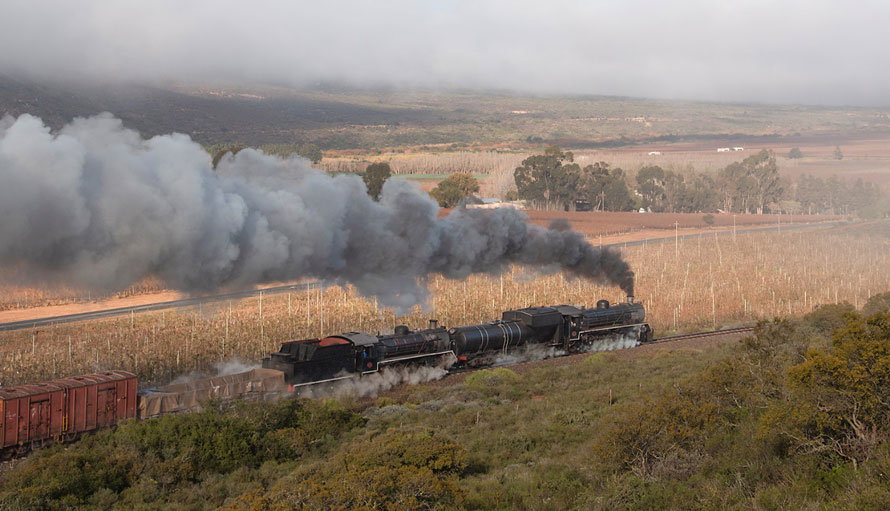
After a long service stop at the locomotive facility there, we headed back up the mainline towards Wolseley, then up the branch to Ceres for the tour’s end.
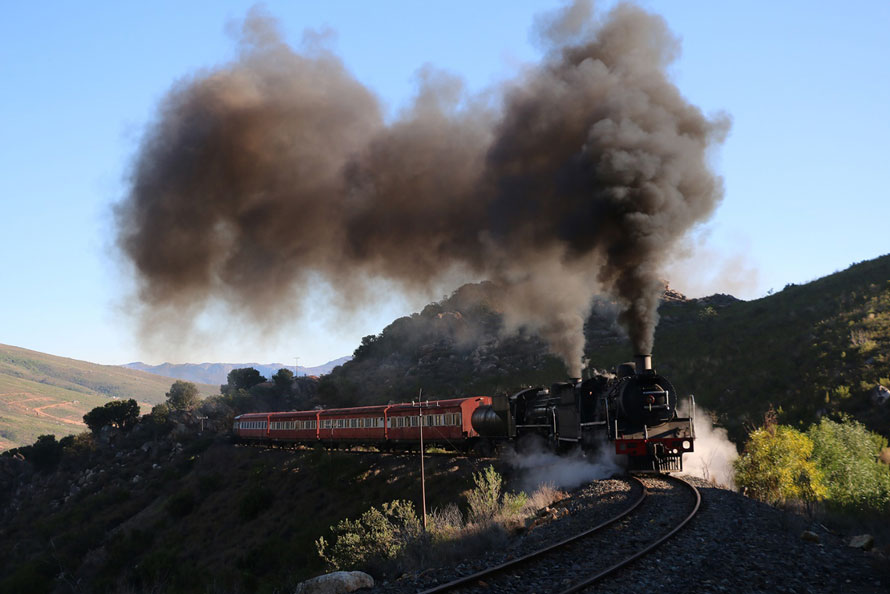
We performed a final photo stop on Michell’s Pass, and I mean final. It seemed that we had planned our fuel use very tightly. We literally arrived back in Ceres with the oil-burning 19D’s fire dead and the last few scoops of coal-dust going into the 19B’s firebox just before we drew to a halt. But we had made it! After many thank-yous and gratuity presentation to the crew, the passengers departed and we were finally able to relax. The tour party stayed over in Ceres that evening and then traveled by coach to Cape Town on the Monday before flying home that evening.
The statistics are maybe of interest. We had traveled 1174 train miles behind steam of four different classes over nine days without any serious locomotive breakdowns or problems. We had performed ninety-five photo-stops for forty-five passengers of nine different nationalities. We had used sixty-five tons of coal and forty-five tons of oil, and there were only minor supply issues. The locomotives had been watered, coaled and oiled every night and prepared by the locomotive support crew every morning. We were always ready for departure on time. The hotel and coach transport had happened seamlessly. Everything had gone as generally planned, but importantly, when problems arose, the Ceres team had managed to think on their feet and respond appropriately. All in all, it had been an extremely satisfying tour for the Ceres staff. But, above all, the smiles on our passenger’s faces said it the most. We had managed to keep South African steam’s banner flying high and after fifteen years had revived the traditional “Steam Safari” tour. The Ceres Rail team were feeling good!
Within three months, FarRail were negotiating a longer, more ambitious tour and two other UK tour operators’ interest had been piqued. By the beginning of 2020, itineraries for the FarRail and the one UK operator had been virtually finalized and we were looking forwards to another interesting and satisfying long-distance rail-tour season for the oncoming year…
. . . and then COVID-19 struck
Peter Rogers – Photographs and text Copyright 2022
This is Part One of a two part story. Click here to read Part Two
This brings back fond memories of the SAR-SATS tour of Oct. 1984.
Art, fond memories indeed, I was the Train Manager on that tour, now I am resident in Philadelphia PA.
I was on the 2019 tour and it really was a masterpiece of good organisation. The weather co-operated too, which meant we went home with some excellent shots!
Beautiful work, Peter!
Thanks!